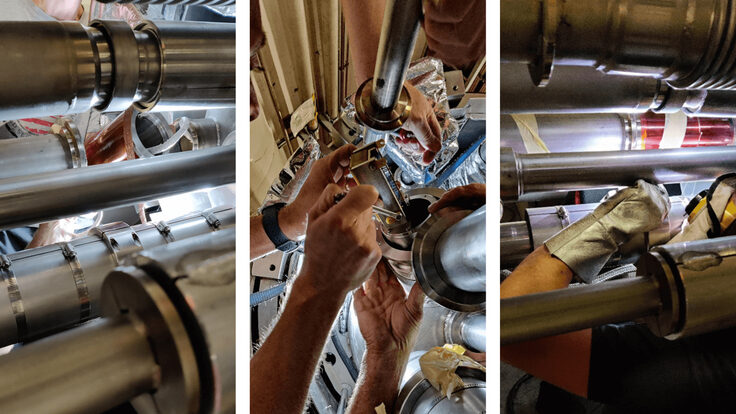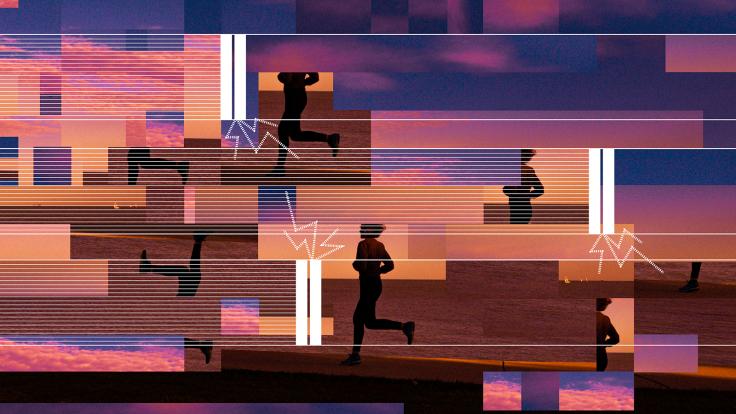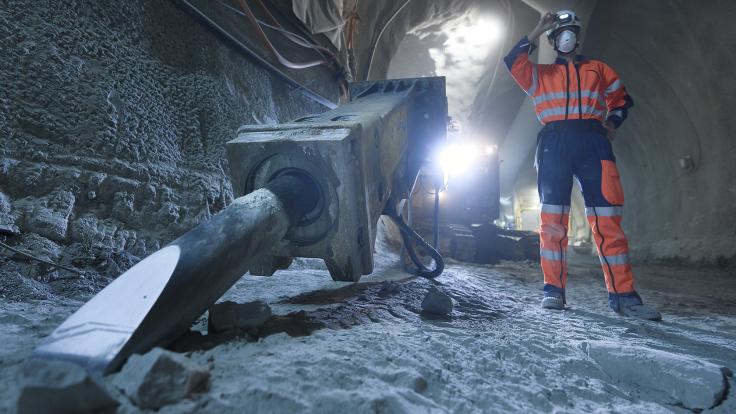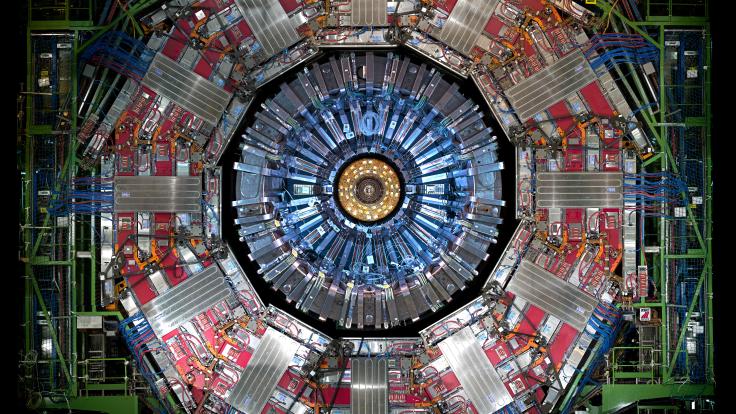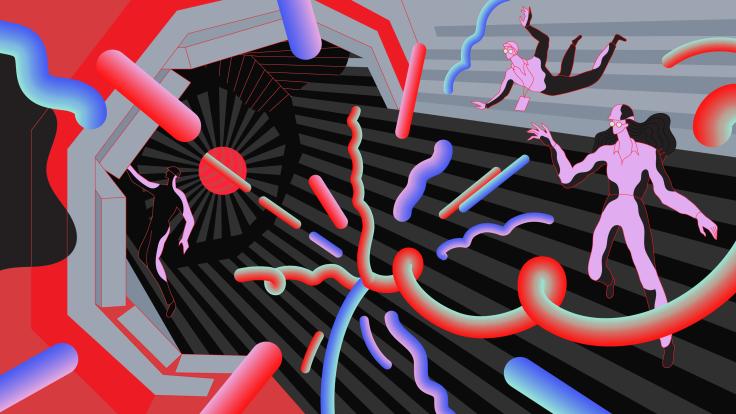After three years of searching, CMS physicist Hannsjörg Weber found what he was looking for. He and his colleagues finally unblinded the data from trillions of collisions at the Large Hadron Collider at CERN, revealing information that was previously hidden–even from themselves.
“We were excited, but also all on edge,” says Weber, a postdoc at Fermi National Accelerator Laboratory, a US Department of Energy Office of Science national laboratory and home base for the CMS experiment in the US. Weber and his colleagues had the first sighting of a rare process in which three massive bosons shoot out from a collision in the LHC. “That was a big relief. It was an amazing feeling.”
This analysis has a special significance to more than just Weber. It also happens to be the CMS collaboration’s 1000th scientific paper, a key milestone for high energy physics experiments. “It’s never been done before in our field,” says Boaz Klima, the CMS publications committee chair and a scientist at Fermilab.
A huge amount of meticulous work and scrutiny goes into each paper published by CMS, a collaboration of about 3000 scientists.
“Each CMS collaborator helps build and operate the experiment, so each paper has every collaborator’s name on it,” Klima says. “We can’t make mistakes or else we jeopardize the reputations of thousands of scientists.”
Tracing the history of the tri-boson discovery paper yields a unique perspective of the process of doing science inside this massive experimental collaboration.
A tri-boson discovery
The story of this analysis starts three years ago during a meeting of the playfully named “Surf and Turf” working group, which at that time consisted of University of California San Diego and UC Santa Barbara (the coastal “surf” contingent) and Fermilab (the Midwestern “turf” contingent). When a colleague suggested searching for three massive bosons emanating from the LHC’s collisions, Weber’s ears perked up.
“I had been looking for supersymmetry for 10 years,” he says. “I was intrigued to look for something new which hadn’t been found yet, but which is also predicted by Standard Model—so we know where to find it.”
Weber and a small team of postdocs and graduate students from UCSD and Fermilab adopted the analysis and started looking through the literature and existing techniques. Together with their professors and staff scientists, they developed a plan and pitched it to the CMS subgroup responsible for that area of research.
According to Weber, preparing the pitch and getting the green light to continue was the easy part. The struggle came when their idea didn’t work out as planned.
“When we did our first full preliminary analysis, we were not happy with the results because we didn’t have good sensitivity for this process,” he says. “We decided to go back to the first step and see if we could improve it.”
Finding a new subatomic process in the mountains of scientific data is like panning for gems in a pebbly river bottom. CMS provides a number of tools to help physicists sift through the noise and tease out the signals, but these standard methods were not good enough for this new analysis. Back at the drawing board, Weber and his colleagues decided to build a new type of data-sieve specially tailored for their needs.
“CMS is great to work in because collaborators can use the preexisting frameworks,” Weber says. “But when you have a new idea for a new tool, you also need to put in that extra time and work to develop it and then send it through CMS’ quality control.”
During that time, the team became aware that a group at Northwestern University was interested in the same type of physics. The two decided to join forces.
Even with their new tool and larger collaboration, they still could not achieve the sensitivity they needed to see the process they were looking for. They published their original search in March 2019 as CMS’ 899th scientific paper.
From these results sprang a new idea. The original analysis looked for only one process: three W bosons radiating from the proton-proton collisions. The team realized that they could greatly increase their chances of seeing three massive bosons if they cast a wider net and included Z bosons in the equation.
“We had gained so much experience that we decided to look at all combinations of W and Z bosons,” he says. “We had more than an idea; we knew exactly how to reach our goal of observation.”
For their ambitious new plan, they needed an even bigger crew. Luckily, their original search had caught the attention of other groups within the CMS collaboration. The California Institute of Technology and Laboratoire Leprince-Ringuet joined shortly afterward.
With new people came new ideas. Two graduate students from Caltech and LLR who specialized in machine-learning algorithms started developing a framework to use to improve their sensitivity.
After nine months of reworking their original ideas into a more sophisticated analysis, they were confident that this time they would have the sensitivity they needed. The next step was convincing the larger CMS collaboration.
“When you want to claim the discovery of something new, your colleagues are extra stringent in how they review your analysis,” Weber says. “They want to make sure that there is nothing anyone could doubt.”
Following several stages of back-and-forth with their group of conveners and then an external analysis review committee, Weber and his colleagues finally got the go-ahead to unblind the data. A few hours later, they saw the signal. After the initial wave of relief, they immediately started preparing themselves for the final stages of review.
“We were looking at our unblinded data and thinking, ‘OK, what could people criticize? What questions will they ask?’”
The analysis team knew that having good results wasn’t the end of the journey and that they would need to defend their tidy paper to both their analysis review committee and then potentially hundreds of other CMS scientists through a process called “collaboration-wide review.”
“During collaboration-wide review, every member of the CMS collaboration gets a direct message saying, ‘This paper is now in CWR, if you want to send in your comments, click here,’” Klima says.
Because of the team’s intense preparation, they were able to quickly address all the questions and concerns raised by their analysis review committee. But when it came to the collaboration-wide review, a misconception started to emerge.
“We were getting comments from colleagues who are not experts in Standard Model physics,” Weber says. “In our case, we realized that our results allowed for a misleading interpretation that we had not considered.”
They carefully reviewed and responded to every comment and delicately re-worked their paper to address the misconception. After another month of intense review, they were ready for the final reading, after which the CMS Publications Committee submitted the paper to the journal Physical Review Letters in June.
“It feels great, but in a way, I also felt a bit empty afterwards,” Weber says. “It was so much work, and while we know where we want to go next with this analysis, we don’t work with the same urgency as we did during the four months of review.”
As the CMS publications chair, Klima sees every paper before it is submitted to a journal. For him, the most impressive aspect of this 1000-paper milestone is not the quantity, but the quality of the work that goes into every paper and the variety of research topics covered.
“The diversity of the physics is astounding,” Klima says. “We’re doing physics that in the past would have been performed by different accelerators and detectors. Because the LHC accelerator and our experiment are performing so unbelievably well, we can now do it all at CMS.”




